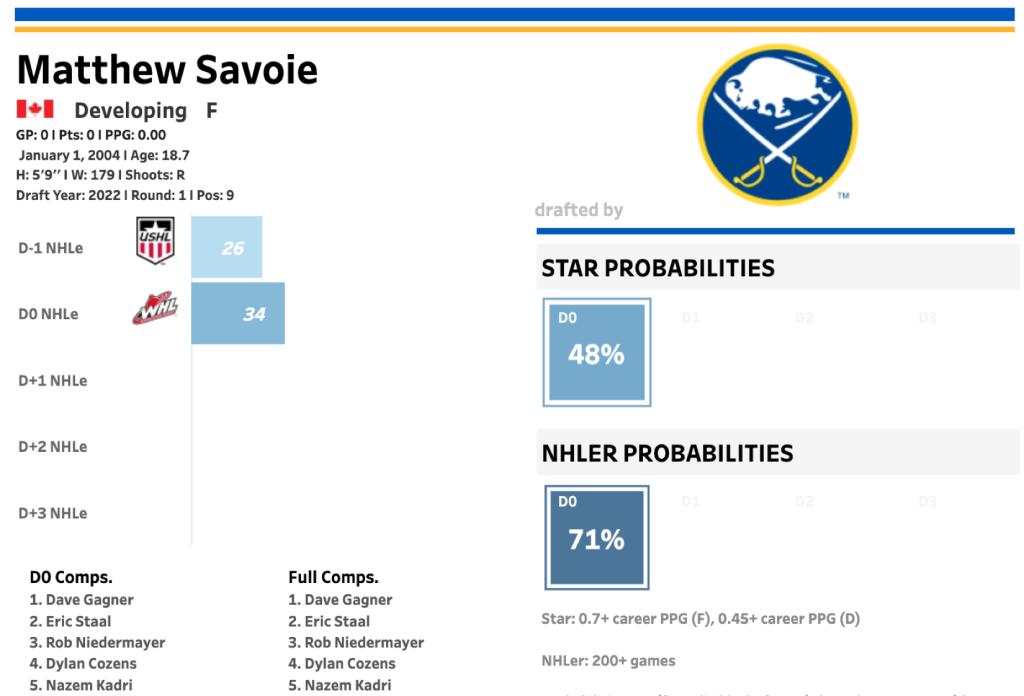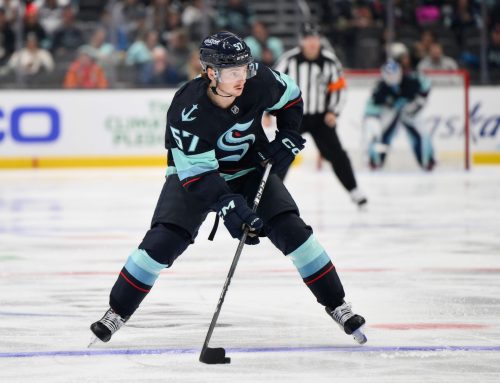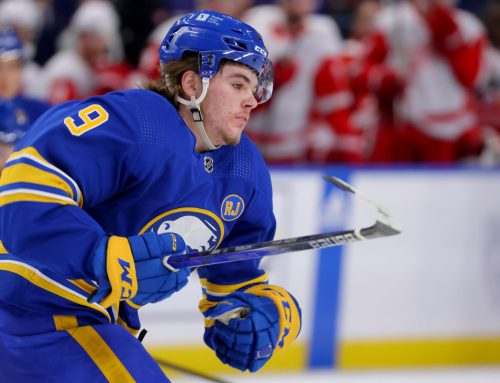The Journey: Exploiting Short-Term Memory – Part Two (Savoie, Frost, Hayton, Tomasino, McMichael)
Ben Gehrels
2022-08-27
Welcome back to The Journey, where we follow hockey prospects and their paths to the NHL, providing fantasy predictions and analysis along the way.
On the one hand, building through the draft in fantasy allows weak teams to acquire high-end assets for free. But when those assets routinely take three-to-five years to start posting meaningful NHL production, managers need to supplement with other strategies to accelerate and strengthen their rebuilds.
Given how many fantasy leagues end up folding after just a few years, it makes sense to try to win at all times. That might sound obvious but it can be tempting to rebuild sort of indefinitely in long-term formats, capturing as many new shiny toys each year through the draft as possible. As discussed two weeks ago in Part One, "upside" can be incredibly alluring.
But even when completely tearing things down, there is no need for a team's timeline to ever exceed, say, three years. With that in mind, there is a case to be made for exploiting short memories by flipping recent draft picks for established assets to accelerate and even strengthen a rebuild—a strategy that can feel counterintuitive to managers used to the standard draft-and-develop approach. Rebuilding teams would usually aim to hoard high-end assets like Matthew Savoie (BUF), for instance.

But in one league I traded Savoie, who I had just drafted ninth overall, for Bo Horvat straight up. I initiated the trade because I knew the other owner really wanted Savoie, and I felt my team was ready to contend. I would traditionally think of that swap as a "win now" move for me, which wouldn't usually make sense for a rebuild, but that type of trade might be savvy even if I was embarking on a longer term rebuild.
Here's why: Horvat, 27, is a boring asset in that he is firmly in his prime and we know exactly what he is by this point. I can expect sixty points a year right away plus 2.5 shots, 0.25 PPPs, a hit, most of a block, and 12 faceoff wins per game. While not elite, except maybe in faceoff leagues, that is solid production.
On the other side, Savoie, 18, will head back to the WHL this year. Then he will hopefully light up the AHL in 2023-24 and join the Sabres the year after that. Then of course he'll need 200 games, most of three seasons, to hit his Breakout Threshold—assuming he stays healthy and progresses almost perfectly. The best case scenario for Savoie owners is that he will be putting up, say, 70+ points in 2027-28.
By then, Horvat is 32 and has likely given me five years of the solid numbers outlined above. That is if my team was contending and I kept him all that time. If I was rebuilding, maybe I hold him for part of a year and then flip him to a contender for a package with two (or more) players like Morgan Frost, Barrett Hayton, Dylan Cozens, Philip Tomasino, and Connor McMichael—young players with a similar profile to Savoie who are less shiny (ie. expensive) because they're a few years past being drafted, but haven't broken out yet.
A move like that, if you can pull it off, exploits the draft hype and short memory of a fellow manager to essentially turn a 2022 lottery ticket (ie. Savoie, Nazar, Slafkovsky) into a couple young players poised to begin posting meaningful production as early as this year, accelerating and strengthening your rebuild at the same time. Perhaps the Horvat step in between is not even necessary if someone in your league is really pumped up about the current year's draft eligible players.
Some of those players mentioned above have lost their lustre so here is a quick reminder of why there was once a good deal of hype surrounding them.
Morgan Frost, PHI
Frost didn't put up Savoie-level production in his draft year but did post an impressive 1.67 points per game campaign in his D+1 and pushed two ppg the year after that (1.88). It remains to be seen whether or not Savoie can exceed that mark next year in the WHL but the point is that there might not be as big of a gap between him and Savoie as it seems right now in terms of eventual upside.
This clip of Frost giving off Kent Johnson vibes is a few years old now but wouldn't it be something if he could find his swagger again?
Frost, still only 23, is on a slow-burn trajectory reminiscent of Jakob Pelletier (CGY): he is now heading into his D+6 season with 77 NHL games under his belt on top of a couple successful AHL seasons. A shoulder injury in 2020-21 derailed what could have been a promising NHL rookie campaign but he was able to play a full slate of games between the AHL and NHL last year, performing admirably with limited ice time and opportunity.
If Frost hits his BT on schedule, his wait time will only be a season and a half from now—again, versus the five-plus seasons for Savoie. His ceiling might not be a top-line forward anymore given his meandering development, but he should still comfortably slot in on a team's second line, somewhat like Horvat.
Barrett Hayton, ARI
Former fifth-overall pick Hayton, 22, is another player who has lost his sheen and should come cheaply in fantasy right now. He too is about a season and a half away from his BT and is poised to see meaningful minutes in the Coyotes' top six.
At the junior level, his production was almost exactly the same as Frost's: a point per game in his draft year, then a jump to 1.69 ppg in his D+1. Although he never really lit up the AHL, his 31-point pace with limited ice time and opportunity last year with the Coyotes was very encouraging.
On top of the points, he drove play very well in a sheltered role and won over 400 face offs with a respectable 48% win rate. Those data points suggest that he will stick at the C position where Arizona is very thin, meaning he could be first in line to play between dynamic young players Clayton Keller, Dylan Guenther, and Logan Cooley (who may slide to the wing) in the coming years. Those players would certainly be a boost from Loui Eriksson and Nick Ritchie, his most common linemates from 2021-22.
Dylan Cozens, BUF
Cozens is a member of the less-distant 2019 draft class (7th overall) and was dominant at last year's WJC (16 points in 7 games), so he might be more highly valued than the previous two players. He also turned in a better scoring rate in his draft year than Frost and Hayton (1.23 ppg) though he ended up with similar point-per-game production in his D+1 (1.67 ppg). At that point, he made the jump directly to the NHL and is progressing more quickly and smoothly than the other two.
Here's his first NHL goal from about a year and a half ago:
Points-wise, Cozens hasn't exactly lit the fantasy world on fire yet, averaging a lowly 35-point pace over his first 120 NHL games. With another full season to go before he reaches his Breakout Threshold, his price will likely never be lower than it is right now.
Unfortunately, Michael Clifford spilled the beans on how good Cozens' 2021-22 season actually was in his recent Ramblings. One nugget that jumped out to me: "[Cozens] was the only Buffalo forward to be above average in scoring chances taken and scoring chances generated for teammates." Hopefully the managers in your league missed that article and only see his underwhelming points output.
If Cozens was the main piece coming back for Savoie/Horvat, and you could manage to convince the other manager to slip in a second post-hype prospect like Frost or Hayton on top, I would make that trade all day.
Philip Tomasino, NAS
Tomasino posted similar numbers to the others in junior: 1.1 ppg in his draft year, 1.58 ppg in his D+2. Then he blew up for over a point-per-game as an AHL rookie before making the jump to the NHL and turning in a solid 32-point effort with only 11 minutes of average ice time.
As a late first rounder in 2019 and a support-role player at last year's WJC (seven points in six games), Tomasino has kept a lower profile than Cozens. Further, his modest rookie production and the bad reputation Nashville has in fantasy circles for developing high-end prospects (Tolvanen, Fiala, Radulov) likely mean that Tomasino can be had at a discount right now.
He is still a couple seasons away from his BT but his NHL certainty is higher than Savoie's at this point, and his trajectory has him headed firmly into top-six territory. Will Tomasino's upside eventually be 5-10 points per year lower than Savoie's? It's impossible to say at this point but that slight potential boost likely isn't worth waiting 3-4 extra years for. Go with the proven option.
Connor McMichael, WAS
McMichael is one of these "sneaky London Knights players," as DP Editor Pat Quinn put it on a recent DraftCast episode, who play a depth role in their draft year and then explode in their D+1 after being given top deployment—Luke Evangalista last year, for instance. A few years ago, McMichael scored just over a point-per-game for the Knights in his D+0, then blew up in his D+1 to the tune of 1.96 ppg before making the jump to the AHL in his D+2 like Tomasino and Hayton.
McMichael is another late 2019 first rounder who is firmly in the NHL now but not yet making a noticeable impact—in large part due to zero powerplay time and ten total minutes of ice time per game. With Nicklas Backstrom set to miss a good chunk of 2022-23, and Tom Wilson also out to start the year, there is more opportunity than usual right now in the Capitals' top six. He will need another couple seasons to hit his BT, like Tomasino but is likewise destined to play in a top six and is nicely on track to hit his ceiling of 80+ points.
Overview
Other young forwards who would make excellent targets using your sexy 2022 draft picks include Peyton Krebs (BUF), Cody Glass (NAS), Thomas Bordeleau (SJS), Brendan Brisson (VGK), Nick Robertson (TOR), Alex Turcotte (LAK), Kirill Marchenko (CBJ), and Gabe Vilardi (LAK). All are close to the NHL and have the chops to make an impact quickly but their value is lower right now than when they were drafted and where it will likely be a year or two from now.
We've touched on quite a few players here so a visual might be helpful. This chart shows each player's point per game production in junior, starting with their Draft year, to help you take in their progression at a glance.
| Player | Draft Year | Draft +1 | Draft +2 |
| Alex Turcotte | 1.68 USDP | 0.9 NCAA | AHL |
| Matt Savoie | 1.38 WHL | N/A | N/A |
| Cody Glass | 1.36 WHL | 1.59 WHL | 1.82 WHL/AHL |
| Brendan Brisson | 1.31 USHL | 0.88 NCAA | 1.11 NCAA/AHL |
| Gabe Vilardi | 1.24 OHL | 1.81 OHL | AHL |
| Dylan Cozens | 1.23 WHL | 1.67 WHL | NHL |
| Philip Tomasino | 1.1 OHL | 1.58 OHL | AHL |
| Connor McMichael | 1.1 OHL | 1.96 OHL | AHL |
| Peyton Krebs | 1.1 WHL | 1.58 WHL | 1.79 WHL/AHL |
| Nick Robertson | 1.0 OHL | 1.87 OHL | AHL |
| Thomas Bordeleau | 0.98 USDP | 1.25 NCAA | 1.0 NCAA/AHL/NHL |
| Barrett Hayton | 0.95 OHL | 1.69 OHL | AHL/NHL |
| Morgan Frost | 0.93 OHL | 1.67 OHL | 1.88 OHL |
| Bo Horvat | 0.91 OHL | 1.37 OHL | AHL/NHL |
| Kirill Marchenko | 0.52 MHL | 1.27 MHL/VHL | 0.52 KHL |
A few caveats: a chart like this is a very basic version of what more sophisticated projection models are doing. It's only taking points into account, it doesn't adjust for different leagues, team systems, deployment, Draft-1 seasons, etc. This also doesn't tell us anything about a given player's skill set, habits, and weaknesses.
That said, a couple things jump out. Glass is the closest CHL player to post an incredible D0 season like Savoie's. But Glass' D+1 pace in the same league then fell below what Frost, Hayton, Cozens, and McMichael all managed the following year. In other words, don't read too far into excellent draft year numbers like Savoie posted in 2021-22. It's a very limited sample.
Plus, as draft analysts pointed out, Savoie earned a ton of his 90 points with the man advantage—which inflated his overall numbers. There is no guarantee he will build significantly on that 1.38 ppg mark next year. More likely he produces in the neighbourhood of 1.5-1.7 ppg like many of these players did. As for Glass, he still has potential of course but his value in fantasy now is miles lower than it was between 2017-2019. It's a reminder of how easily players like Savoie can lose value.
Another insight here is that while we know Horvat is a near-star-level producer now (52-point career average that is increasing each year), his production was a couple steps below most of these guys at the same age. This is where those caveats come into play: Horvat basically stepped straight into the NHL in his D+3—a difficult feat really only replicated by Cozens from this group of players.
That speaks to Horvat's complete, two-way game. In fantasy, that can be the kiss of death in some cases (think of how some people are panicking about Anton Lundell's upside because of his two-way prowess) but those concerns can also be overblown. As we've seen, Horvat would be a valuable addition to almost every fantasy squad even if his ceiling is 65-70 points because he reliably hits, shoots, and gets PPP.
Again, don't sell the farm for a theoretical 5-15 point bump five years down the road. Upside isn't everything.
Thanks for reading! Follow me on Twitter @beegare for more prospect content and fantasy hockey analysis.
One Comment
Leave A Comment
You must be logged in to post a comment.





 CAR
CAR NYI
NYI BOS
BOS TOR
TOR VAN
VAN MTL
MTL EDM
EDM WPG
WPG SEA
SEA

a few years back I drafted Studnicka in the mid 20s and another owner was pissed. he traded me danault straight up. I got late 20s multi cat steady Eddie to help me win another championship, this was a keep the window open deal, and now that window is closing and I’m looking to trade danuault for some of the post hypers u mention.